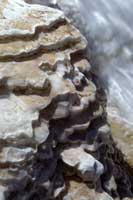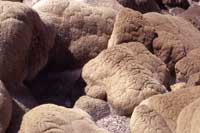|
Lobby > Exhibits > Scientific Research > Hydrothermal Research > Vital Signs of the Earth > A Mountain Turning Inside Out > Travertine and Geyserite
Hydrothermal Research
TRAVERTINE AND GEYSERITE
 Travertine
Travertine
Underlying bedrock: Limestone (sedimentary)
Composition: Calcium carbonate
How is it deposited? Warm, carbon dioxide-rich waters dissolve calcium carbonate from the underlying bedrock. The calcium carbonate precipitates out of solution when the carbon dioxide is released.
Usual rate of deposition: Rapid
 Geyserite
Geyserite
Underlying bedrock: Rhyolite (volcanic)
Composition: Silica
How is it deposited? Superheated water dissolves silica from the underlying bedrock. Geyser water splashes onto the ground, forming hard, translucent, bulbous, or spiny shapes called geyserite.
Usual rate of deposition: very slowly—perhaps only an inch or two in a hundred years.
Next |
1 > 2 > 3 > 4 > 5 > 6 | Return to: Scientific Research

|

This work is supported by
 
|
|

 Travertine
Travertine Geyserite
Geyserite

